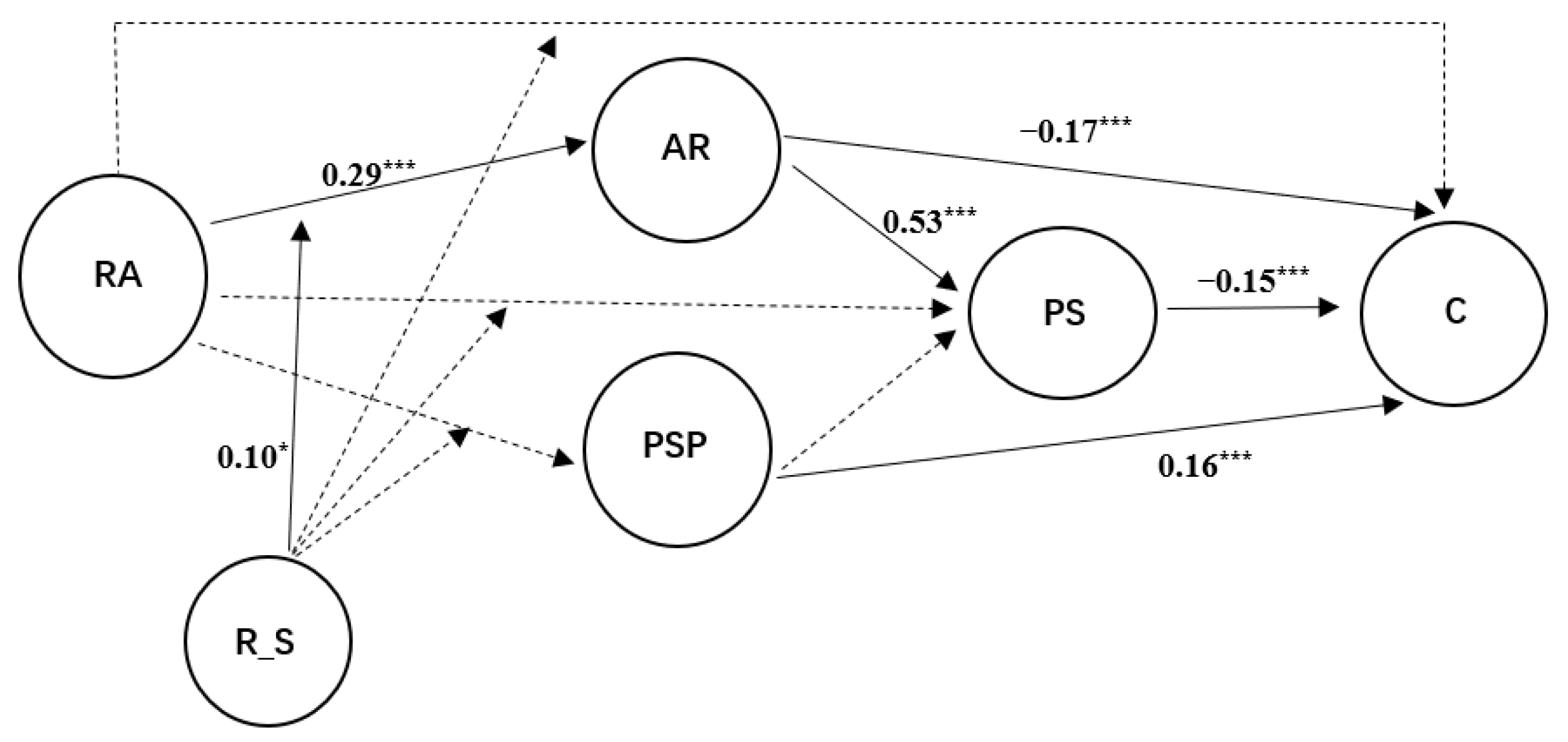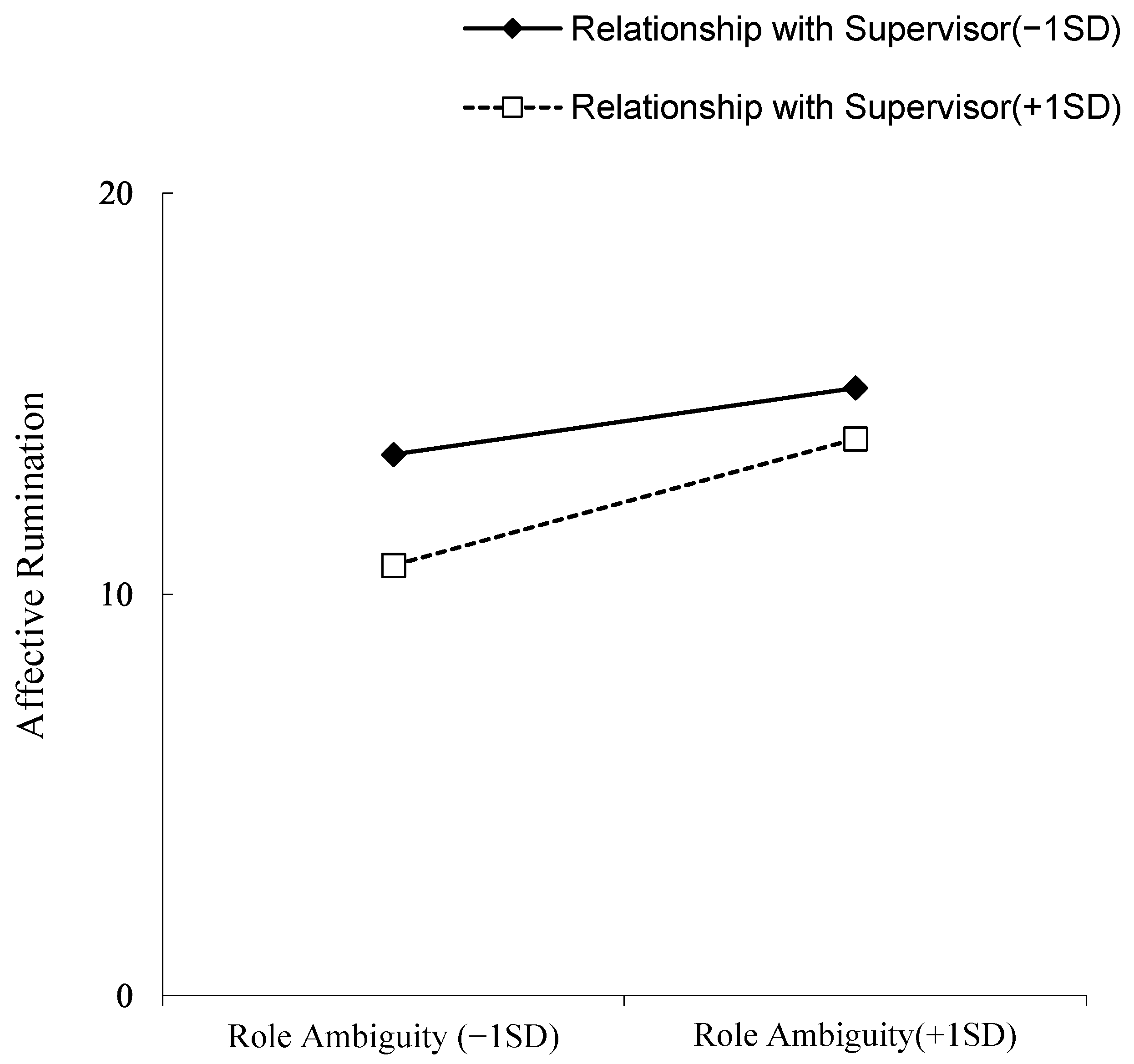The Relationship between Role Ambiguity and Workers’ Creativity during the COVID-19 Pandemic in China
Abstract
1. Introduction
1.1. Role Ambiguity and Creativity
1.2. The Demands–Resources–Individual Effects (DRIVE) Model
1.3. Relationship with Supervisor
2. Methods
2.1. Sample and Procedure
2.2. Measures
“Are you troubled by work-related issues when not at work?” (affective rumination).
“In my free time, I find myself re-evaluating something I have done at work.” (problem-solving pondering).
“Please rate on the extent to which yourself searches out new technologies, processes, techniques, and/or product ideas.”
2.3. Assessment of Common Method Variance
3. Results
3.1. Preliminary Analyses
3.2. Hypothesis Testing
4. Discussion
5. Conclusions
5.1. Contributions
5.2. Practical Implications
5.3. Limitations and Future Research
Author Contributions
Funding
Institutional Review Board Statement
Informed Consent Statement
Data Availability Statement
Conflicts of Interest
References
- China Internet Network Information Center. The 47th Statistical Report on Internet Development in China. Available online: http://www.cnnic.net.cn/hlwfzyj/hlwxzbg/hlwtjbg/202102/t20210203_71361.htm (accessed on 5 February 2021).
- Gilboa, S.; Shirom, A.; Fried, Y.; Cooper, C. A meta-analysis of work demand stressors and job performance: Examining main and moderating effects. Pers. Psychol. 2008, 61, 227–271. [Google Scholar] [CrossRef]
- Tubre, T.C.; Collins, J.M. Jackson and Schuler (1985) revisited: A meta-analysis of the relationships between role ambiguity, role conflict, and job performance. J. Manag. 2000, 26, 155–169. [Google Scholar] [CrossRef]
- Antón, C. The impact of role stress on workers’ behaviour through job satisfaction and organizational commitment. Int. J. Psychol. 2009, 44, 187–194. [Google Scholar] [CrossRef]
- Yan, C.H.; Ni, J.J.; Chien, Y.Y.; Lo, C.F. Does workplace friendship promote or hinder hotel employees’ work engagement? The role of role ambiguity. J. Hosp. Tour. Manag. 2021, 46, 205–214. [Google Scholar] [CrossRef]
- Mark, G.M.; Smith, A.P. Stress models: A review and suggested new direction. In Occupational Health Psychology: European Perspectives on Research, Education and Practice; Houdmont, J., Leka, S., Eds.; Nottingham University Press: Nottingham, UK, 2008. [Google Scholar]
- Webster, J.R.; Beehr, T.A.; Love, K. Extending the challenge-hindrance model of occupational stress: The role of appraisal. J. Vocat. Behav. 2011, 79, 505–516. [Google Scholar] [CrossRef]
- Carasco-Saul, M.; Kim, W.; Kim, T. Leadership and employee engagement: Proposing research agendas through a review of the literature. Hum. Resour. Dev. Rev. 2015, 14, 38–63. [Google Scholar] [CrossRef]
- Yun, S.; Takeuchi, R.; Liu, W. Employee self-enhancement motives and job performance behaviors: Investigating the moderating effects of employee role ambiguity and managerial perceptions of employee commitment. J. Appl. Psychol. 2007, 92, 745–756. [Google Scholar] [CrossRef]
- Wang, S. Thinking Outside of the Box when the Box is Missing: Examining the Curvilinear Relation between Role Ambiguity and Creativity. Ph.D. Thesis, University of Illinois at Urbana-Champaign, Champaign, IL, USA, 2009. [Google Scholar]
- Wang, Y.; Huang, Q.; Davison, R.M.; Yang, F. Role stressors, job satisfaction, and employee creativity: The cross-level moderating role of social media use within teams. Inf. Manag. Amster 2021, 58, 103317. [Google Scholar] [CrossRef]
- Akgunduz, Y.; Alkan, C.; Gök, Ö.A. Perceived organizational support, employee creativity and proactive personality: The mediating effect of meaning of work. J. Hosp. Tour. Manag. 2018, 34, 105–114. [Google Scholar] [CrossRef]
- Anderson, N.; Potočnik, K.; Zhou, J. Innovation and creativity in organizations: A state-of-the-science review, prospective commentary, and guiding framework. J. Manag. 2014, 40, 1297–1333. [Google Scholar] [CrossRef]
- Syed, F.; Naseer, S.; Bouckenooghe, D. Unfairness in stressful job environments: The contingent effects of perceived organizational injustice on the relationships between job stress and employee behaviors. J. Gen. Psychol. 2021, 148, 168–191. [Google Scholar] [CrossRef] [PubMed]
- Byron, K.; Khazanchi, S.; Nazarian, D. The relationship between stressors and creativity: A meta-analysis examining competing theoretical models. J. Appl. Psychol. 2010, 95, 201–212. [Google Scholar] [CrossRef] [PubMed]
- Wang, S.; Zhang, X.; Martocchio, J. Thinking outside of the box when the box is missing: Role ambiguity and its linkage to creativity. Creat. Res. J. 2011, 23, 211–221. [Google Scholar] [CrossRef]
- Grobelna, A. Role ambiguity: A problem or a challenge facing contemporary hospitality industry. The critical role of employees’ creativity. Int. J. Contemp. Manag. 2015, 14, 77–98. [Google Scholar]
- Maden-Eyiusta, C. Role conflict, role ambiguity, and proactive behaviors: Does flexible role orientation moderate the mediating impact of engagement? Int. J. Hum. Resour. Manag. 2021, 32, 2829–2855. [Google Scholar] [CrossRef]
- Martínez-Díaz, A.; Mañas-Rodríguez, M.Á.; Díaz-Fúnez, P.A.; Limbert, C. Positive Influence of Role Ambiguity on JD-R Motivational Process: The Moderating Effect of Performance Recognition. Front. Psychol. 2020, 11, 550219. [Google Scholar] [CrossRef]
- Emirbayer, M.; Mische, A. What Is Agency? Am. J. Sociol. 1998, 103, 962–1023. [Google Scholar] [CrossRef]
- Coelho, F.; Augusto, M.; Lages, L.F. Contextual Factors and the Creativity of Frontline Employees: The Mediating Effects of Role Stress and Intrinsic Motivation. J. Retail. 2011, 87, 31–45. [Google Scholar] [CrossRef]
- Liu, J.; Liu, Y. Reducing the harmful impact of work stress on creativity? Buffering model of available resources. Open. J. Soc. Sci. 2020, 8, 62. Available online: http://creativecommons.org/licenses/by/4.0/ (accessed on 16 July 2021). [CrossRef]
- Mazzola, J.J.; Disselhorst, R. Should we be “challenging” employees?: A critical review and meta-analysis of the challenge-hindrance model of stress. J. Organ. Behav. 2019, 40, 949–961. [Google Scholar] [CrossRef]
- Cropley, M.; Zijlstra, F.R.H. Work and rumination. In Handbook of Stress in the Occupations; Langan-Fox, J., Cooper, C.L., Eds.; Edward Elgar Publishing Ltd.: Cheltenham, UK, 2011; pp. 487–503. [Google Scholar]
- Zhang, J.; Li, W.; Ma, H.; Smith, A.P. Switch off Totally or Switch off Strategically? The Consequences of Thinking about Work on Job Performance. Psychol. Rep. 2021, 124, 2721–2738. [Google Scholar] [CrossRef] [PubMed]
- Kinnunen, U.; Feldt, T.; de Bloom, J.; Sianoja, M.; Korpela, K.; Geurts, S. Linking boundary crossing from work to non-work to work-related rumination across time: A variable-and person-oriented approach. J. Occup. Health Psych. 2017, 22, 467–480. [Google Scholar] [CrossRef] [PubMed]
- Li, Y.P.; Tu, Y.D. Does high LMX quality benefit subordinate’s career Success? A moderated mediation study. Acta Psychol. Sin. 2011, 43, 941–952. (In Chinese) [Google Scholar] [CrossRef]
- Cropley, M.; Michalianou, G.; Pravettoni, G.; Millward, L.J. The relation of post-work ruminative thinking with eating behaviour. Stress Health 2012, 28, 23–30. [Google Scholar] [CrossRef] [PubMed]
- Scott, S.G.; Bruce, R.A. Creating innovative behavior among R&D professionals: The moderating effect of leadership on the relationship between problem-solving style and innovation. In Proceedings of the 1994 IEEE International Engineering Management Conference-IEMC’94, Dayton North, OH, USA, 17–19 October 1994; IEEE: Piscataway, NJ, USA, 1994; pp. 48–55. [Google Scholar] [CrossRef]
- Williams, G.; Smith, A.P. Using single-item measures to examine the relationships between work, personality, and well-being in the workplace. Psychology 2016, 7, 753–767. [Google Scholar] [CrossRef]
- Omosehin, O.; Smith, A.P. Adding new variables to the Well-being Process Questionnaire (WPQ)–Further studies of workers and students. J. Educ. Soc. Behav. Sci. 2019, 28, 1–19. [Google Scholar] [CrossRef][Green Version]
- Antwi, C.O.; Fan, C.J.; Aboagye, M.O.; Brobbey, P.; Jababu, Y.; Affum-Osei, E.; Avornyo, P. Job demand stressors and employees’ creativity: A within-person approach to dealing with hindrance and challenge stressors at the airport environment. Serv. Ind. J. 2019, 39, 250–278. [Google Scholar] [CrossRef]
- Podsakoff, P.M.; MacKenzie, S.B.; Lee, J.Y.; Podsakoff, N.P. Common method biases in behavioral research: A critical review of the literature and recommended remedies. J. Appl. Psychol. 2003, 88, 879–903. [Google Scholar] [CrossRef]
- Akbolat, M.; AMARAT, M.; Çiğdem, U.Ğ.; Feyza, B.O. The mediating role of role overload in the effect of role conflict and role ambiguity on work harassment. Acıbadem Üniversitesi Sağlık Bilim. Derg. 2022, 13, 423–428. [Google Scholar] [CrossRef]
- Elsafty, A.; Shafik, L. The Impact of Job Stress on Employee’s Performance at one of Private Banks in Egypt during COVID-19 Pandemic. Int. Bus. Res. 2022, 15, 24–39. [Google Scholar] [CrossRef]
- Nygaard, A.; Dahlstrom, R. Role stress and effectiveness in horizontal alliances. J. Mark. 2002, 66, 61–82. [Google Scholar] [CrossRef]
- Liden, R.C.; Wayne, S.J.; Stilwell, D. A longitudinal study on the early development of the leader-member exchange. J. Appl. Psychol. 1993, 78, 662–674. [Google Scholar] [CrossRef]
- Minnen, M.E.; Mitropoulos, T.; Rosenblatt, A.K.; Calderwood, C. The incessant inbox: Evaluating the relevance of after-hours e-mail characteristics for work-related rumination and well-being. Stress Health 2021, 37, 341–352. [Google Scholar] [CrossRef] [PubMed]
- O’Connor, P.J.; Jimmieson, N.L.; Bergin, A.J.; Wiewiora, A.; McColl, L. Leader Tolerance of Ambiguity: Implications for Follower Performance Outcomes in High and Low Ambiguous Work Situations. J. Appl. Behav. Sci. 2022, 58, 65–96. [Google Scholar] [CrossRef]
- Flaxman, P.E.; Julie, M.; Bond, F.W.; Kinman, G. Academics’ experiences of a respite from work: Effects of self-critical perfectionism and perseverative cognition on post respite well-being. J. Appl. Psychol. 2012, 97, 854–865. [Google Scholar] [CrossRef]


| Variables | 1 | 2 | 3 | 4 | 5 | 6 |
|---|---|---|---|---|---|---|
| 1 RA | 1 | |||||
| 2 AR | 0.34 ** | 1 | ||||
| 3 PSP | −0.05 | 0.03 | 1 | |||
| 4 R_S | −0.16 ** | −0.30 ** | 0.17 ** | 1 | ||
| 5 PS | 0.18 ** | 0.56 ** | 0.06 | −0.25 ** | 1 | |
| 6 C | −0.26 ** | −0.38 ** | 0.22 ** | 0.47 ** | −0.29 ** | 1 |
| M | 2.80 | 13.24 | 16.94 | 5.20 | 3.97 | 28.13 |
| SD | 1.65 | 4.07 | 2.78 | 1.15 | 1.39 | 7.61 |
| Variable | AR | PSP | Perceived Stress | Creativity | ||||
|---|---|---|---|---|---|---|---|---|
| β | SE | β | SE | β | SE | β | SE | |
| RA | 0.29 *** | 0.18 | −0.01 | 0.13 | −0.02 | 0.06 | −0.63 | 3.37 |
| AR | 0.53 *** | 0.02 | −0.17 *** | 0.08 | ||||
| PSP | 0.07 | 0.02 | 0.16 *** | 0.09 | ||||
| Perceived stress | −0.15 *** | 0.22 | ||||||
| R_S × RA | 0.10 * | 0.18 | −0.12 * | 0.13 | 0.06 | 0.06 | 4.69 | 27.50 |
| Age | −0.30 *** | 0.05 | ||||||
| Gender | −0.03 | 0.51 | ||||||
| Education | −0.01 | 0.39 | ||||||
| Working tenure | 0.02 | 0.37 | ||||||
| Working setting | −0.23 *** | 0.23 | ||||||
| Management position | −0.23 *** | 0.51 | ||||||
| Average working hours per day | 0.00 | 0.13 | ||||||
| IEV | Boot SE | 95% CI Limit | ||
|---|---|---|---|---|
| (Lower) | (Upper) | |||
| RA → AR → C | −0.33 | 0.09 | −0.55 | −0.18 |
| RA → PS → C | 0.01 | 0.04 | −0.06 | 0.08 |
| RA → AR → PS → C | −0.15 | 0.05 | −0.27 | −0.07 |
Publisher’s Note: MDPI stays neutral with regard to jurisdictional claims in published maps and institutional affiliations. |
© 2022 by the authors. Licensee MDPI, Basel, Switzerland. This article is an open access article distributed under the terms and conditions of the Creative Commons Attribution (CC BY) license (https://creativecommons.org/licenses/by/4.0/).
Share and Cite
Zhang, J.; Hong, Y.; Smith, A.P. The Relationship between Role Ambiguity and Workers’ Creativity during the COVID-19 Pandemic in China. Int. J. Environ. Res. Public Health 2022, 19, 15977. https://doi.org/10.3390/ijerph192315977
Zhang J, Hong Y, Smith AP. The Relationship between Role Ambiguity and Workers’ Creativity during the COVID-19 Pandemic in China. International Journal of Environmental Research and Public Health. 2022; 19(23):15977. https://doi.org/10.3390/ijerph192315977
Chicago/Turabian StyleZhang, Jing, Yidan Hong, and Andrew P. Smith. 2022. "The Relationship between Role Ambiguity and Workers’ Creativity during the COVID-19 Pandemic in China" International Journal of Environmental Research and Public Health 19, no. 23: 15977. https://doi.org/10.3390/ijerph192315977
APA StyleZhang, J., Hong, Y., & Smith, A. P. (2022). The Relationship between Role Ambiguity and Workers’ Creativity during the COVID-19 Pandemic in China. International Journal of Environmental Research and Public Health, 19(23), 15977. https://doi.org/10.3390/ijerph192315977







